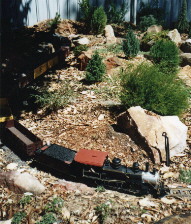The Founding of Selbyville
The story of how
Sometimes crime DOES pay
Updated 14th. March, 1998
 back to one particular moment in time or to one particular
individual. Most places evolve from a dwelling to a
settlement to a hamlet to a town and the early history
becomes lost because the evolution is so gradual that nobody
thought it was worth recording.
back to one particular moment in time or to one particular
individual. Most places evolve from a dwelling to a
settlement to a hamlet to a town and the early history
becomes lost because the evolution is so gradual that nobody
thought it was worth recording.Not so Selbyville.
Emmett Selby founded Selbyville on December 11th., 1872, when he cut down the first Douglas fir to establish his potato farm. In a matter of months he had not only built his cabin and planted his first crop, he had started a thriving business with local gold prospectors, arranging the services of ladies of loose virtue from Seattle to alleviate the social pressures that these men of mineral wealth found themselves subject to.
Selby added cabins and out-buildings to his farm as he established himself and as dictated by the demands for private assignation sites by his clients. As the local gold was mined out and the seekers of its instant wealth drifted from the area, they were replaced by families from the East settling the valleys for its agricultural treasures and its lumber.
Also a number of former seamstresses from Seattle who found themselves with children to raise found need in the community for their services as cooks,washerwomen and even wives of lonely adventurers.
Emmet Selby, as the first settler, became the patriarch of the growing community, expressing his opinions in his forceful Irish way and brooking little interference with his goals and plans. As the initial settler and main food supplier he was in an interesting position of authority, as the odd dissident found out on disagreeing with him.
Food shipments had a habit of arriving or not arriving depending on Emmett's feelings about the recipient, and in an area where winter could close the rudimentary tracks for days at a time, this was a strong hold Emmett had on the hearts and minds of the locals.
As new farms became productive and livestock bred, the implied threat to the food supply dissipated. Emmett's importance, however, did not. By that time, he had, through his contacts in Seattle, sewn up a monopoly on the wagon transport into the valley, so that while the consumables may have changed, the control over them had not.
He started a small general store to supply lamp oil and matches and tobacco, and brought in the odd case of good whisky to pass on at savagely inflated prices.
Needless to say, he prospered and as the years passed he changed from coniving con-man to pillar of the community.
He
believed firmly in the Golden Rule:
he who has the gold
makes the rules.

Selbyville grew as the needs of the area grew. The blacksmith
and livery stable was as necessary to this area at this time
as the gas station is today, so very soon the sound of
hammer on anvil echoed through the surrounding woods.
A rudimentary lumber yard was established to produce building materials for the incoming settlers and of course, all work and no play.., so quite soon a small brewery lent its distinctive aroma to the other late-19th. century smells of smithy's charcoal, firewood and horse droppings.
Interestingly, the brewery was instrumental in the founding of a saloon and that in turn caused a number of the former seamstresses from Seattle to return to their previous occupation. This didn't settle very well with the local churchified people but as usual if there was money to be made, Emmett Selby had a finger in it and so their opinion didn't carry too much weight.
At about this time, Selby bought a cast-iron safe from San Fransisco, ordered out of the Sears catalogue, and founded the First National Bank of Selbyville. He poured into it his by now considerable assets and offered the locals such attractive rates on loans that rapidly new homes and stores were springing up all over the valley, fleshing out the hamlets of Rowel Flat, Fenster and Selbyville to the point where they began to consider themselves towns.
 This in
turn attracted merchants from outside into the valley and the future
seemed assured.
This in
turn attracted merchants from outside into the valley and the future
seemed assured.
The rates from the bank went up a little but it was
boom times so not too many people complained and then they went up
again, but everyone was still eating and then they went up again and
Emmett Selby found himself owner of a brewery and a saloon and a
lumberyard and most of Main St.
But he offered such attractive
rental terms that people kept their heads above water and continued
to trade.
The joint communities had heard via the newly established
Toenail Ridge Examiner of the revolution in transport that
had connected the East coast to the West via the joining of the
transcontinental railroad tracks and so talk began about the
possibility of connecting the valley with the outside world via the
steel ribbons of rail.
The land transport of the day was entirely horse-based, either by wagon or passenger coach, over roads that were only dignified by that name because they were busier than identical tracks. Regular movement between the three towns of the valley had caused these tracks to widen and straighten as trees were cut and erosion levelled and filled, but beyond the confines of the immediate area the region was almost as track-less as before the gold strikes.
 The only road out of the mountain-locked area was via
a steep and treacherous switch-back trail winding down a pass
adjacent to a sheer un-named granite and basalt cliff, so that while
some intercourse occured into and out of the valley, it was never
frequent or busy and it took an outsider a definite act of will to
gain access to the protected zone.
The only road out of the mountain-locked area was via
a steep and treacherous switch-back trail winding down a pass
adjacent to a sheer un-named granite and basalt cliff, so that while
some intercourse occured into and out of the valley, it was never
frequent or busy and it took an outsider a definite act of will to
gain access to the protected zone.
But typical of the philosophy of
the day, the people believed that anything was possible given enough
cheap labor and enough steam-powered machinery, so an approach was
made to the infant Territory legislature to seek rail access.
Needless to say, this delegation of citizens was led by none other than Emmett Selby, prime mover and chief capitalist. It's interesting how a few years and a few gold nugget finds will legitimize a man.
Selby found on arrival at Portland that a number of the important leaders were in fact former clients of his back in the goldrush days. Now with wives, families and eminent positions, most were not adverse to sharing a glass with Emmett but did not relish the thought that he may inform the genteel Portland inhabitants of the nature of their elected representatives back in the old days.
In rapid time, so rapid that in a couple of cases bills were signed before they had been drafted, a charter had been established to proceed with the survey and plan for a rail connection.
The people of the valley had their admiration for Selby further enhanced by this result.
 The establishment of the Toenail Ridge Shortline has been
documented in other places, as well as the dramatic
departure from the valley of Emmet Selby in company with
the wife of the head surveyor of the line.
The establishment of the Toenail Ridge Shortline has been
documented in other places, as well as the dramatic
departure from the valley of Emmet Selby in company with
the wife of the head surveyor of the line.
After the initial upheaval caused by the disappearance of the bank and its equity, the local folk found that while their savings may have disappeared, so had their mortgages and in the end, the only real losers were the deep hills miners and to most of them, the money wasn't really the goal, it was the finding of it, so they just went out prospecting again.
 Click on the links in blue to:
Click on the links in blue to:
Return to Main Page
-read about The building of the Ridge
-learn of The founding of the Ridge
Chapter 3 in the story of the Toenail Ridge Shortline!